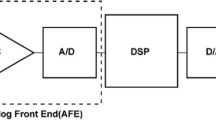Abstract
An analog hearing aid with the function of frequency compensation is proposed and implemented considering the human factors. Introducing the current-mode technique, a filter designed by the state space methodology is integrated in the hearing aid to offer the function which only appears in the DSP unit of digital hearing aid. Combined with the filter embedded in the driver circuit adopting the minimum current selecting technique, the enhance frequency compensation can well match to the common low-frequency hearing loss with a stopband attenuation of 80 dB/dec. Moreover, a low-noise automatic gain control (AGC) is presented to improve the programmability with discreet gains, knee points and compression ratios. To enhance the comfortable level, the attack time and release time is set 20 and 100 ms with a peak detector. The input-referred noise is below 5 μVrms. The hearing aid can drive a 16 Ω receiver at the supply voltage of 1 V. The die area is 2.3 × 1.5 mm2 (AGC) and 0.93 × 0.86 mm2 (driver) in a 0.13 μm standard CMOS process and 1 × 1 mm2 (filter) in a 0.35 μm standard CMOS process.
















Similar content being viewed by others
References
David, W., Mark, R., Tho, H., David, P., & James, N. (1992). A single-chip hearing aid with one volt switched-capacitor filter. In Proceedings of IEEE CICC, pp. 7.5.1–7.5.4.
Gata, D. G. (2002). A 1.1 V 270μA mixed-signal hearing aid chip. IEEE Journal of Solid-State Circuit, 37(12), 1670–1678.
Kim, S., Lee, S. J., Cho, N., Song, S.-J., & Yoo, H.-J. (2008). A fully integrated digital hearing aid chip with human factors considerations. IEEE of Solid-State Circuits, 43, 266–274.
Silva-Martinez, J., Solis-Bustos, S., & Schellenberg, M. (1999). A CMOS hearing aid device. Analog Integrated Circuit and Signal Processing, 21, 163–172.
Li, F., Yang, H., Liu, F., Yin, T., & Wang, X. (2012). Dual-mode gain control for 1 V CMOS hearing aid device with enhanced accuracy and energy-efficiency. Analog Integrated Circuits and Signal Processing, 72, 495–504.
Gata, D. G., & Sjursen, W. (2002). A 1.1-V 270-μA mixed-signal hearing aid chip. IEEE Journal of Solid-State Circuits, 37, 1670–1678.
Samet, M., Masmoudi, M., & Mouine, J. (1998). A new single chip automatic gain control for hearing aids. Proceedings of IEEE Canadian Conference of Electrical and Computer Engineering, 2, 758–761.
Kim, S., Lee, J.-Y., Song, S.-J., Cho, N., & Yoo, H.-J. (2002). An energy-efficient analog front-end circuit for a sub-1-V digital hearing aid chip. IEEE Journal of Solid-State Circuits, 42(4), 876–882.
Kim, S., & Lee, J.-Y. (2005). A 0.9 V 67 μW analog front-end using adaptive-SNR technique for digital hearing aid. IEEE International Symposium on Circuits and Systems, 1, 740–743.
Razavi, B. (2001). Design of analog CMOS and integrated circuits. New York: McGraw-Hill Companies Inc.
Gan, R. Z., Feng, B., & Sun, Q. (2004). Three-dimensional finite element modeling of human ear for sound transmission. Annals of Biomedical Engineering, 32(6), 847–859.
Katsuhiko, O. (2002). Modern control engineering. Upper Saddle River: Prentice-Hall Inc.
Kyehyung, L., Qingdong, M., et al. (2009). A 0.8 V, 2.6 mW, 88 dB dual-channel audio delta-sigma D/A converter with headphone driver. IEEE Journal of Solid-State Circuits, 44(3), 916–927.
de Langen, K.-J., & Huijsing, J. H. (1998). Compact low-voltage power-efficient operational amplifier cells for VLSI. IEEE Journal of Solid-State Circuits, 33(10), 1482–1496.
Serra-Graells, F., Gomez, L. & Farres, O. (2001). A true 1 V CMOS log-domain analog hearing-aid-on-a-chip. ESSCIRC 2001, Proceeding of the 27 European, 405–408.
Acknowledgments
Project supported by National Natural Science Foundation of China (Project 61106025, 61204045) and by the CAS/SAFEA International Partnership Program for Creative Research Teams.
Author information
Authors and Affiliations
Corresponding author
Rights and permissions
About this article
Cite this article
Wang, X., Yang, H., Li, F. et al. A programmable analog hearing aid system-on-chip with frequency compensation. Analog Integr Circ Sig Process 79, 227–236 (2014). https://doi.org/10.1007/s10470-014-0264-6
Received:
Revised:
Accepted:
Published:
Issue Date:
DOI: https://doi.org/10.1007/s10470-014-0264-6




